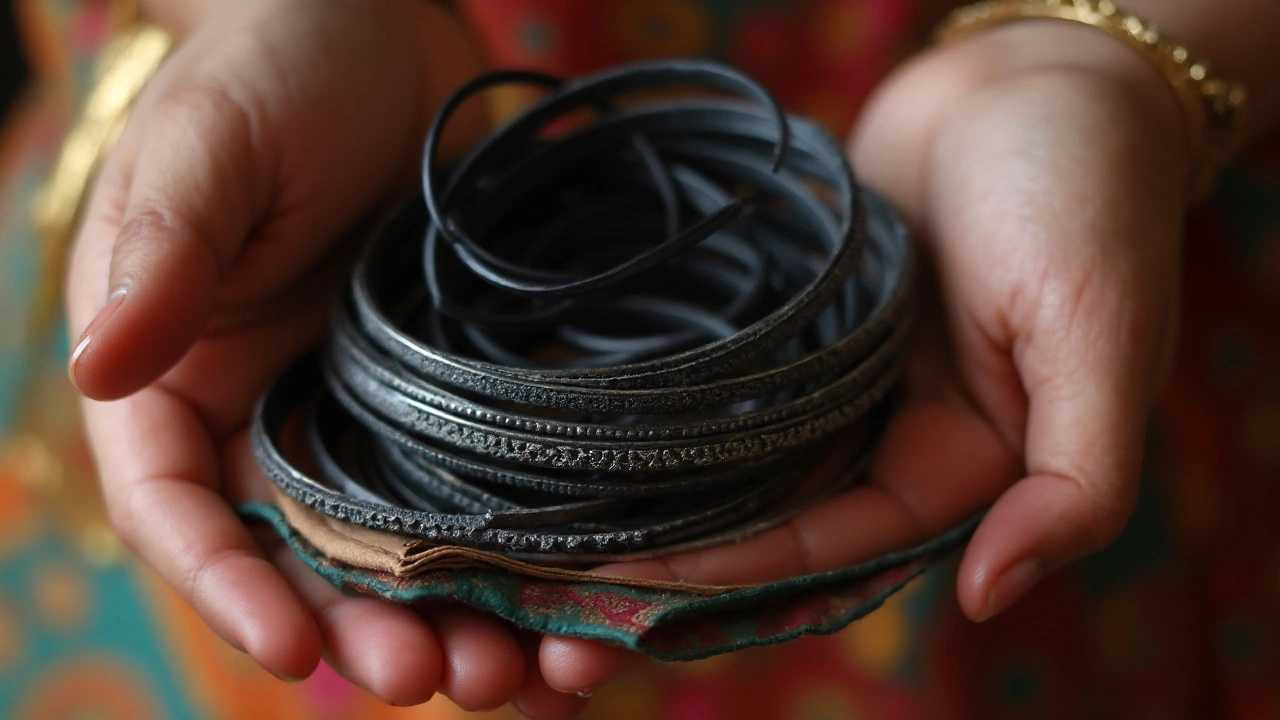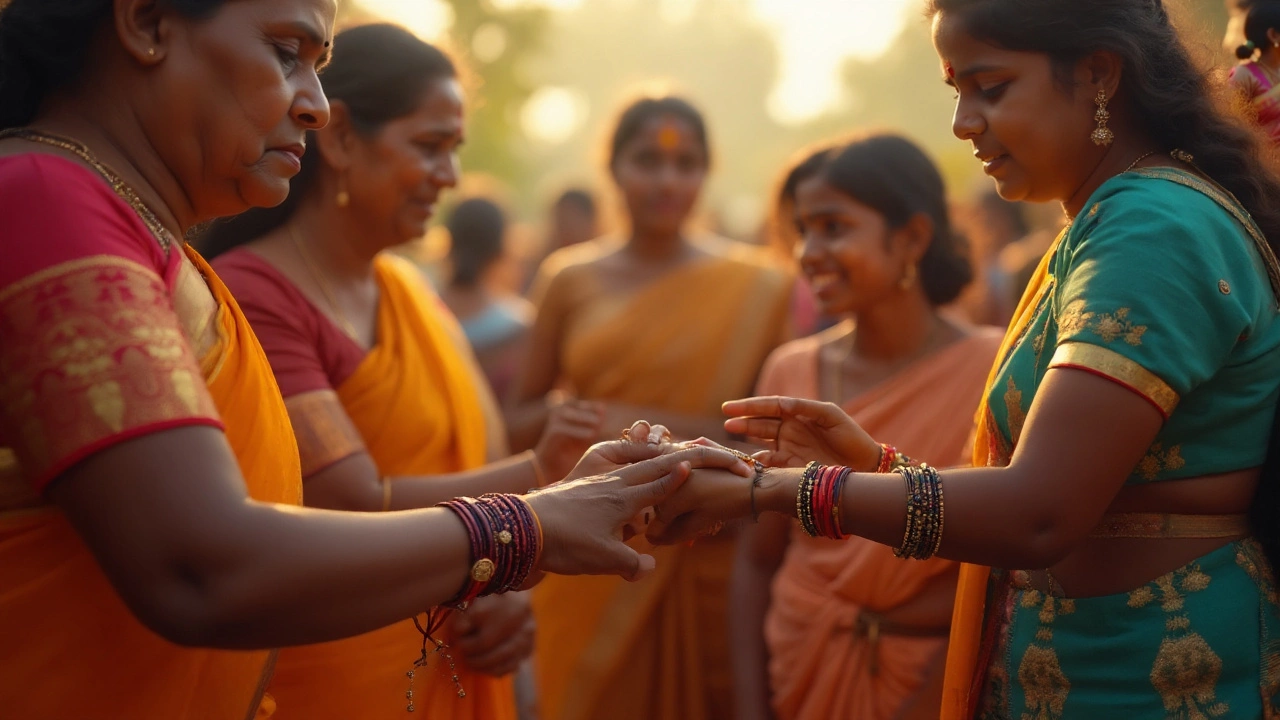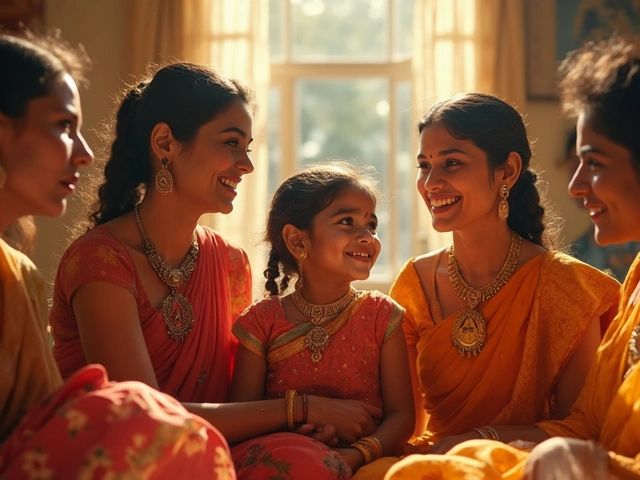Black bangles turn heads for more than just their bold look. In neighborhoods and shopping stalls across India, they dangle from wrists like secrets waiting to be told. Why do so many people pick black, out of all the bangles on display?
It’s not just about fashion. For generations, women – young girls, married women, and even grandmothers – have picked black bangles for reasons that reach deep into their beliefs, their hopes for their family, and even a dash of superstition. You might spot a newborn with a soft black thread tied on a tiny wrist, or notice a South Indian bride mixing black glass bangles with red and gold. There’s always a story behind these choices.
The Ancient Roots of Black Bangles
Black bangles go way further back than most street markets or jewelry stores you see today. This trend lives in family photo albums, dusty temples, and stories passed over cups of chai. It starts with the earliest belief: black wards off evil. That’s old-school protection right there. In India, the idea that black absorbs negative energy dates to ancient times. You’ll see it everywhere. Doorways marked with black dots, cars with a black thread dangling from the rear-view mirror, and yes, wrists circled with black bangles.
Black bangles became a daily shield for women, especially pregnant women or newborn babies. The fear of the “buri nazar” — the evil eye — is strong in Indian culture. Parents put black bangles or little black beads on their children for safety. There’s a belief that if you catch the eye of jealousy or malice, the black absorbs that negativity instead of letting it harm the child. You hear stories like, “My grandmother would never let me leave the house without my black bangle,” or, “My sister’s newborn wore them home from the hospital.”
Historians trace this to the use of kohl (“kajal”) and simple black threads and beads even during the Mughal era. Artwork from ancient India shows gods and goddesses adorned with bangles. In South India, villagers still tie black beads for blessings. It’s not just for looks, but for luck. Black bangles entered folklore, poems, and even local remedies. For instance, some midwives still tie black bangles on new mothers, believing it keeps bad spirits away.
Indian culture isn’t the only one to use black jewelry for protection. The Mediterranean’s use of black beads as “mati” for the evil eye, and the Middle Eastern black thread traditions, tell us this idea connects ancient civilizations across continents. But in India, the bangle isn’t just for babies and brides — it’s a core part of everyday wear, especially for those who want that extra layer of cultural backup.
Symbolism in Everyday Life: From Ritual to Fashion
If you walk through a busy Indian bazaar, black bangles come right alongside the bright ones — reds for marital bliss, greens for fertility, yellows for joy. So why black? While it started as a protective charm, black bangles started picking up extra baggage. In some parts, they meant marital status. In other places, they hinted at a woman’s independence, especially as black bangles started crossing lines from tradition into modernity.
The symbolism depends a lot on region and context. In rural Maharashtra, black glass bangles are essential for married women, especially after certain rituals like Mangalagaur or Gudi Padwa. In South India, brides often get black and gold bangles during their wedding as part of the “kanganam” or “valaiyal” ceremony. It’s believed they not only protect marriage but also strengthen the bond between the couple. And in urban India, young women flaunt black bangles as a nod to both tradition and style — sometimes mixed with jeans and tops, not just saris or salwar kameez.
For some communities, black is taboo during happy rituals, but that’s not a universal rule. Urban women may wear black bangles for everyday use, and sometimes even mix it up for a festival look. A popular workwear hack: one black bangle alongside a silver watch, striking a balance between office dress code and cultural pride.
But black bangles aren’t just about what’s on the outside. There are stories of girls slipping on black glass bangles in secret, thinking it’ll help crushes notice them or shield them from heartbreak. And let’s talk about pop culture. Bollywood movies love using bangles as a symbol — look for that pivotal “chudi ki khanak” (the bangle’s sound), sometimes bittersweet, sometimes celebratory. Black bangles, in particular, appear in scenes meant to show independence, defiance, or a subtle mystery.

Black Bangles in Different Cultures and Religions
Beliefs about black bangles aren’t just regional; they also change with religion and family tradition. Hindu, Muslim, Sikh, Jain — you’ll find bangles everywhere, but the meaning can shift. In some states like Gujarat and Rajasthan, black bangles aren’t worn by married women during festivals, while in Bengal, black and red “paat” glass bangles are a regular sight on new brides. In Muslim communities, wearing black stone or onyx bangles during Muharram isn’t rare.
In Christian families in South India, black bangles sometimes replace the red thread for infants, showing a blend of faith and custom. Sikh mothers will often tie black threads, or “kala dhaaga,” for similar superstitious reasons. Each community adds its own twist. For example, in Kerala, the “pavithra modiram” (a type of black-tinted ring or bangle) represents good luck, and in Goa, black glass is considered the safest pick for children after certain temple visits.
Wearing black bangles during mourning? That’s actually a myth. Black for grief may be common in Western attire, but in Indian bangles, black doesn’t always mean sadness. In fact, in urban cities, black is a top choice for parties and formal events, carried off with black sarees or Indo-Western fusion outfits.
Let’s look at the numbers for context:
| Region | Common Bangle Colors for Married Women | Black Bangle Purpose |
|---|---|---|
| Maharashtra | Green, Red, Black | Protection & Prosperity |
| Punjab | Red, Ivory, Gold | Infancy Protection |
| Bengal | Red & White (Shankha Pola) | Used with Red for Bridal Sets |
| Tamil Nadu/Kerala | Gold, Black, Red | Child Protection, Good Luck |
The quote “Bangles are much more than jewelry; they are silent storytellers on a woman’s wrist,” comes from esteemed crafts historian Dr. Ritu Sethi. That captures why tradition runs deep.
Modern Trends: Fashion or Folklore?
Today, black bangles have made a huge leap from just being family heirlooms or talismans. Instagram and TikTok put them right next to global trends. Young women mix black glass bangles with stackable gold or silver ones. Black metal bangles are paired with Western dresses or denim. Even men are warming up to black wrist accessories as part of the recent minimalist trend.
Jewelry designers catch on: black bangles with crystals or semi-precious stones, name engravings, or designer motifs. You’ll spot celebrities like Priyanka Chopra or Deepika Padukone wearing black bangles for public appearances — half as a nod to tradition, half as a style move. Major brands like Amrapali and Jaypore have launched lines with black bangles for urban buyers. According to a 2024 Mintel India report, demand for ethnic jewelry with modern twists rose by 37% last year, with black accents topping online search charts.
If you want to stay ahead of bangle trends, here’s a quick pro tip: Combine black bangles with metallic cuffs for a layered, sophisticated look. Or, try pairing one statement black bangle with a handful of colorful glass bangles for a playful touch. Most important, if you’re gifting bangles, giving a plain black one (especially with a gold accent) is seen as both chic and respectful — a rare win-win in fashion and tradition.
DIY is catching on, too. Websites offer black bangle-making kits, right from basic glass to resin and metal. There are meet-ups in cities like Mumbai and Hyderabad where people host “bangle parties” and teach the art of stacking and styling black bangles. Even among Gen Z men, black “bracelets” made with beads or woven threads have become an everyday staple, merging tradition with self-expression.

Picking, Wearing, and Caring for Black Bangles
Not all black bangles are created equal. In the old days, glass was king — it makes a sharp sound, signaling good luck and chasing away bad vibes. But if you’re a daily bangle wearer, you know glass isn’t the most practical. Metal black bangles, black lac, plastic resin, or black beaded versions are everywhere now, and some have special coatings to resist scratches and sunlight.
Choosing black bangles often starts with what you believe: If you want luck and traditional vibes, go for glass or stone. If you’re all about fashion, experiment with shapes, thicknesses, and stacked layering. For newborns, doctors now recommend soft black cotton or silk threads to prevent skin irritation — a nod to old customs with a modern twist. And if you have metal allergies, pick hypoallergenic metals or glass.
Here’s a quick care guide:
- Store glass bangles in padded boxes; avoid dropping them.
- Wipe metal bangles with a soft dry cloth after use to avoid tarnish.
- Keep black bangles away from perfumes and harsh soaps.
- For kids, avoid using tight or sharp-edged bangles.
- Check the edges of glass bangles before wearing to avoid small cuts.
If you’re traveling abroad, check if metal bangles set off airport security. If you lose a bangle, some believe it’s a sign to replace it quickly, not to break the chain of protection.
Wearing black bangles doesn’t have to be complicated. Some mix and match for each mood. Others stick with a single piece for years. It’s less about a rulebook, and more about what feels comfortable and meaningful for you. That’s the beauty of black bangles — side by side with trends, they quietly carry years of beliefs, memories, and hope for good fortune.



